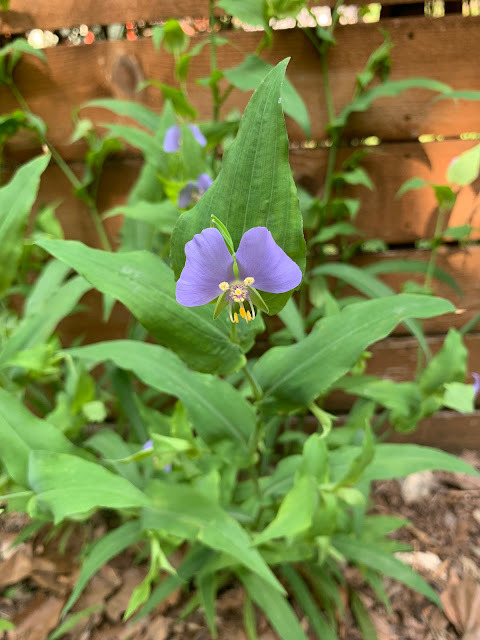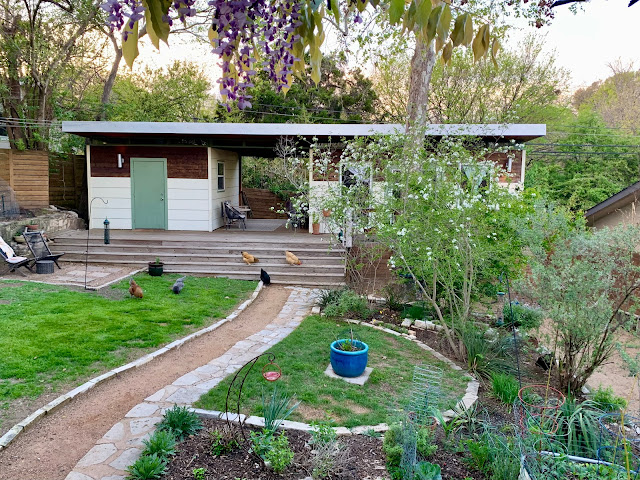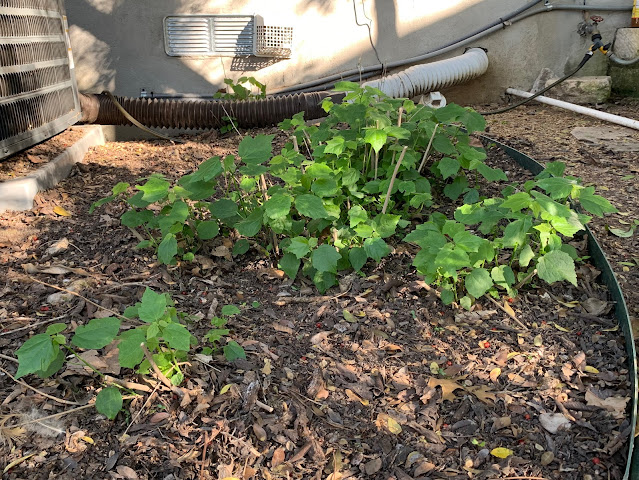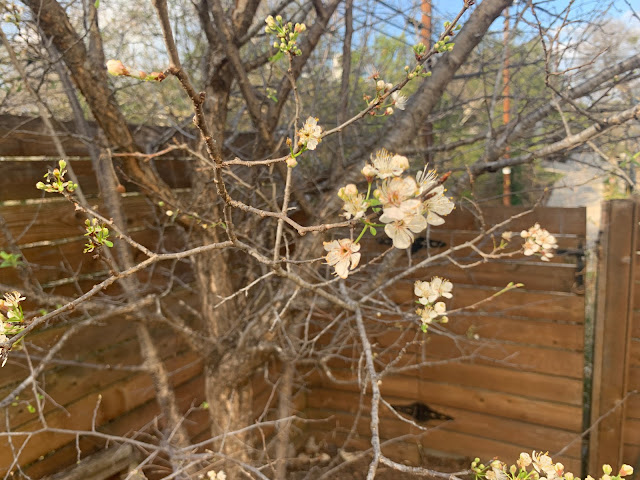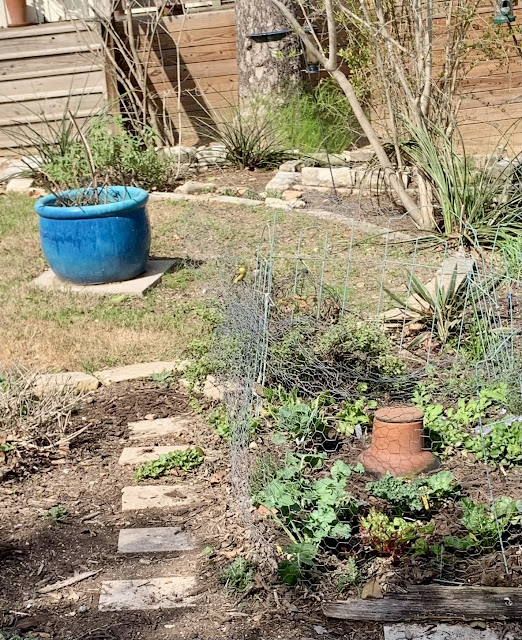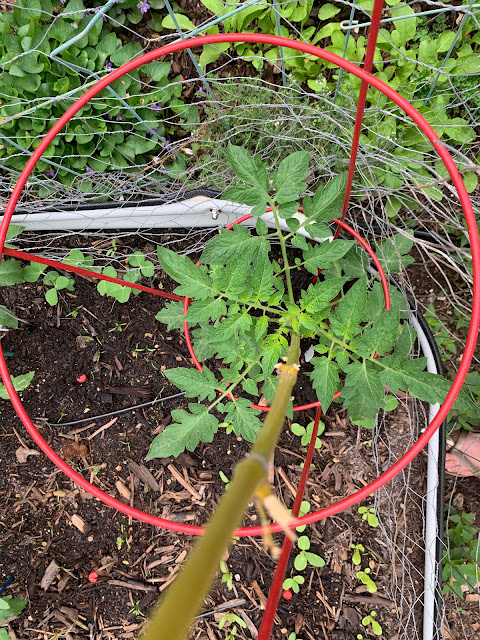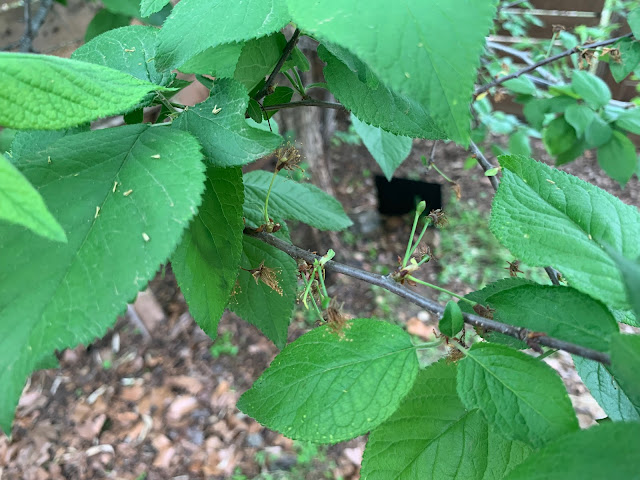The wisteria and anacacho orchid tree are blooming and my back yard smells delicious. I've taken quite a few pictures from this angle in the past and it made me think of what has worked in my yard, and what hasn't over the last 17 years that I've lived in the house. Every yard has its own microclimate and mine (Travis Heights, clay-ish soil with rocks, becoming more partially shaded as trees grow, no watering system except for in my veggie bed) has changed over the years as trees have grown in and light has changed. I started a list of friends or foes- plants that either work well with minimal effort, or those that I work to eradicate. I'll post about them when they look pretty with future posts. Of course, the house was built in 1950, so some of my friends and foes have been here longer than I have been on the planet!
Friend/native or xeric:
Plains coreopsis
Engelmann’s daisy
Inland sea oats
Turks cap
Flame acanthus
Frostweed
Purple coneflower
White mistflower
Zexemenia
Evening primrose
Lantana
Goldenrod
Mexican plum tree
Cenizo in the right place
Kidneywood
Rock rose as long as you let it grow where it wants to be
Red spider lily- I have been slowly buying bulbs and placing them throughout the front yard beds
Anacacho orchid tree
Friend/not native or xeric but hold up well regardless:
Yellow unnamed hand-me-down irises
Oregano
Fennel (I don't get any bulbs for cooking, but the swallowtail butterflies love to lay caterpillars making the fronds worthwhile)
Parsley (a biennial, so I have to replant it periodically)
Garlic chives (need some chicken protection but once the chickens have alternatives they leave alone)
Random amaryllis bulbs chunked into the soil after blooming indoors. They don't always rebloom every year, but they come out and surprise me pleasantly every so often
Dutch blue irises (not bearded)- a big box store purchase that come up regularly every spring. When the strappy leaves get brown in the summer well after blooming I tie them into "pretty" knots to look tidy
Daffodil/narcissus- they might not always flower though
Hyacinth bulbs- come back regularly every early spring and smell great
Pomegranate tree
Came with the house and help out:
Drummond’s onion
Horseherb
American elm tree
Cherry laurel tree
Yaupon holly
Red Oak tree
Sycamore tree
Mountain laurel
Ruellia carolinensis (Carolina wild petunia)
Passionflower vine
Rain lily
Wild violet
Came with the house and have pluses and minuses:
Henbit
Carolina snailseed
Purple bindweed
Mustang grapevine
Virginia creeper
Wild violet (spreading everywhere)
Came with the house and is not native but smells good and the bees like it:
Wisteria
Foe:
Bamboo
Stickyweed
Cat claw vine
Tree of heaven
Ligustrum (waxy, I think)
Failed:
- Texas Redbud- Despite coming as a gift from my mother from The Natural Gardener (my favorite nursery) it never put out many colorful buds in the spring. I would drive around the neighborhood having bud envy! It grew well, but froze during Snowpocalypse.
- Ornamental plum- It was in place in the front yard when we bought the house and died swiftly and definitively. It made a good scaffolding for Halloween decor for a year or two.
- St Augustine grass- I don’t particularly like chemicals, pesticides and fertilizer. I also never installed a watering system. That means my St Augustine lawns in the front and back yards were doomed. My eldest (now 17) had a few good years rolling in the grass in our yard, but by the time my youngest (age 13) came around I let it die in the back yard. I replaced it first with Thunderturf (seeds with mixture of native grasses), then I let leftover Bermuda grass and horseherb take over when the Thunderturf died due to lack of.. something- probably sun and attention. I reduced the grass area in the front yard significantly by carving out beds along the edges. I keep the small remainder in the front hobbling along so that my eldest doesn’t complain too much about me taking away all of his grass. I spread out a small amount of anti-grub poison once or twice a year (its the front yard so no chickens or veggies are there), top dress it with compost, add occasional organic fertilizer, add corn meal gluten at all the wrong times (damn you dichondra) and try to remember to water it once a week when it gets hot.
- Mexican bush sage- wrong place, not enough sun
- Artemisia- same as above
- Mealy blue sage- same as above
- Plumeria (gifted from a friend, it hardly ever flowered though I moved it to many places looking for the right sun exposure, then I let it freeze)
- Missouri primrose- I love the flowers, but I can’t keep them going in my front yard- maybe too much partial shade, maybe the wrong microclimate.
- Squash/renegade pumpkins/intentional zucchini plants- Last year every specimen I had was destroyed by squash vine borers. Will take a hiatus from them this year.. maybe.
- Any bearded irises that aren’t the hand-me-down yellow irises that were rescued from the yard across the street. The non-yellow ones are expensive- and I’ve had at least 5-8 of them fade away in various spots in my yard. I bought three more last fall at Barton Springs nursery in a fit of optimism but while my yellow ones are blooming away, the new ones have barely grown an inch of leaves.
- The cenizo in my front yard- It is slowly slowly withering. I should probably just take it down, but it gives me a place to hang a wind-thingy gift from my sister-in-law.
Did well for a while until sun/physical space changed:
- Coral honeysuckle- It grew fantastically, until we took away the fence that acted as a trellis. Understandably, it never bounced back after getting a severe trim for that. It likes sun.
- Pyracantha- It is non native, but was nicely thorny in front of a bedroom window so it gave a feeling of security. It put out orange berries just in time for Halloween and looked great with the rest of the seasonal decorations. It was excessively trimmed by a crew that my husband hired and died soon after, probably because its light was blocked by the flourishing Red Oak in the front. I think it has a descendent growing out of a crack in the stonework that lines the front bed- I’ve been humoring it (I have a sentimental streak).
- Corn poppies- my chickens ate them all :( I threw out more seeds this winter and might get one or two. If you don't have chickens they are worth the investment (a few dollars for a seed packet).
- Old Gay Hill Rose- It was a small 4" pot found at Barton Springs nursery and did really well until the last two years. I think the Snowpocalypse and this recent freeze did it in. It did well with partial shade and with no supplemental water- so if you want a tough climbing-ish rose with pretty red blooms and you can find it- plant it!
- Purple lantana in the front- I think the Red Oak has grown so much it doesn’t get enough sun. It used to be riotous a decade ago and drought tolerant. I’m trying plumbago in there now.
- Zinnias- my chickens eat them, I don’t water them and they might not get enough sun. Nevertheless, I’m trying again this year.
- Salvias under my kidneywood and pomegranate- not enough sun.
- Lambs ears- they wither after a season
- Lavender- I can't find the balance between too much water/rotting and not enough/drying up
- Mexican feather grass- They did well for about 5 years, then were outcompeted by the irises. I still have a few. They look great planted in large groups.
A few pictures of my friends and foes:
Friends:
Plains coreopsis, golden tickseed- what it looks like right now:
What it will look like in 1-2 months
Native to the western plains, it has naturalized widely. It has stuck around the most from native wildflower seed packets I threw out years ago and self seeds itself regularly. It provides nectar for bees and butterflies and seeds for birds. Native Americans apparently used root tea to treat diarrhea and as an emetic. Zuni women drank tea made from the plant (not the roots) to help conceive daughters. Multiple groups made dye from the plant as well.
Engelmann's Daisy
It is a native perennial that comes back every spring, tolerating even the pecking from my chickens who take nibbles of the green leaves that come out before most other plants in the garden. My plants have come back easily from all of our winter storms and are also heat and drought tolerant. Birds eat the seeds and butterflies and bees enjoy the nectar. Really, my only problem with them is that they get ragged by mid summer and so I have to trim their brown stems and leaves sequentially through late summer and fall. Luckily I have yellow/orange lantana plants next to them that fill in around that time and take over the bed for the rest of late summer until the first freeze, covering up the ragged daisy rosettes well.
Turks Cap
(last fall)
(this spring)
Before I started gardening beyond pots of herbs on a balcony I thought Turks Cap was boring- such coarse leaves, such small flowers that don’t even open all of the way. Now though that I have a yard full of partial shade (and no watering system except for my veggie bed) I am huge, enormous fan of Turks cap! It’s a native, drought tolerant shade plant that reliably comes back from the roots to grow into big handsome shrubs that hide my AC unit and attracts butterflies, bees, and hummingbirds. My Turks cap plants tolerated Snowpocalypse and the recent freezes just fine. They even have the cutest fruit (“apples”) that taste ok if a little bland- I pick them on walks in the neighborhood and eat them. Apparently the flowers and young leaves can be eaten raw or cooked. One site said the flowers taste wonderful (“like honeysuckle”) and are loaded with nectar. I’ll have to try them this year. The flowers can make a pink lemonade type drink and the fruit can be made into tea or preserves. The flowers have antioxidants, the leaves are high in minerals; and the fruit is high in vitamin C if you need to fight scurvy. Chickens don’t eat them.
As for invasiveness- Turks cap does so well in my yard that it does self-seed - mostly a bonus in that I get many free plants to fill in the places I want. When they are poorly positioned I don’t usually have the heart to pull the seedlings, though I will need to do so on some that are growing in a gap between the stone edging of a bed and the stairs up to my house walkway as you see in the picture above.
Inland Sea Oats
Are native to Texas and do well in partial shade. They line the old stone wall in my back yard to soften the edge and they fill in well and have pretty seedheads in the fall. They are supposed to like moist areas but I find mine do ok with minimal water in the back partial shade. They do try to self seed and since the far back area is “wild” I generally let them. I usually pull the seedlings up in the immediate back yard (I really should pot them and take them to a plant swap at some point instead). At times they almost look like my main foe bamboo so some clumps get dug up as I dig to see if they are connected to a bamboo root. Mammals and birds eat the seeds (though I can’t find any mention that they are edible for humans) and they are larval host plants to several skipper butterflies- of which I’ve seen the Bell’s roadside skipper and Bronze roadside skipper in the garden before. Also birds use the stems and leaves as nesting material.
Flame acanthus
Volunteer
Just starting to grow this spring
Flame acanthus is a shrubby drought tolerant perennial native to Texas to Mexico. I use them to cover up my AC unit and along the wall in the far back. Some flowers are orange, some are brighter/redder. Bees and hummingbirds enjoy its nectar and I love watching the hummingbirds. I haven’t quite figured out how to shape my plants near my back porch so they don’t grow lanky and flop over, though apparently I should shear them to make a hedge. I just trim back any particularly wild or free form branches that are in my way. They freely self seed and so I have a ton of self-sown ones in my back yard. I’ve gotten better about pulling the ones that are inconveniently located. Again, I should pot the ones I don’t want and give them away- they dig up fairly easily. I let the ones in the far back grow as far as they want and they usually form a 4-5 foot wide mass. My chickens leave them alone (well, my chickens will dig at the roots of any newly planted plant in my garden, but once established they have no interested in flame acanthus).
Frostweed

I picked up a frostweed at a Wildflower Center plant sale and it has liberally self-seeded in shade areas in my garden, which is a mixed blessing. I put a seedling in the middle of my partial shade circle bed (where I didn’t have enough sun for Artemisia or Mexican bush sage) and it has become a drought tolerant large healthy perennial plant that dies back to the roots in winter but returns reliably every spring. It grows tall, lush and provides small white flowers in the fall that bees and butterflies enjoy- but then it gets overgrown and tends to flop all over its neighbors with heavy rains. I keep it because it provides nectar for monarchs during their fall migration. It’s also a host plant for Bordered patch butterflies. I should have spaced it farther from the Nolina next to it because it crowds it out. Its oozing phloem does make a really fascinating ice-like sculpture form when it freezes (called crystallofollia) which gives me something to look for and appreciate when most other plants look grim. I don’t think it is edible but apparently indigenous people dried its leaves and used them tobacco. Plant it if you need to fill in a partially shady area with easy and self-seeding native plants that that attract bees and butterflies, but put it somewhere that you won’t mind coarse leaves and hulking shape.
(note the volunteer flame acanthus in the lower left corner..)
Came with the house:
Drummond’s onion - Native to prairies and meadows and is a nectar source for bees. Brightens up the hilly grass next to my wall and pops up in my garden too. I haven’t tried to spread it but I’ve let it grow where I find it (even waiting until flowering before mowing in the spring). Indigenous Cheyenne would boil meat with it for flavor and eat the bulbs.
American elm tree
Early spring green
It is currently snowing seeds
Seedling that needs to be pulled
It is a native tree found widely throughout the US. I’m happy with the old large trees that shade the house between us and our neighbors. But they try to seed everywhere and so I am frequently on the lookout to pull seedlings where I don’t want them. They are host plants to multiple butterflies and moths: Question mark, Painted Lady, and Mourning cloaks.
Left alone in the back yard:
Henbit:
Is not native and was apparently brought over to North America as fodder for chickens. My girls would probably eat it though they don’t seem too enthusiastic about it. Henbit can apparently be consumed fresh or cooked as an edible herb, and it can be used in teas. The stem, flowers, and leaves are edible and it is high in iron, vitamins and fibre. According to Natural Medicinal Herbs this edible plant is anti-rheumatic (helps w aches and pains), a febrifuge (so could be used for fevers if you are stuck with nothing else), but you should watch out because it it can also be a laxative and a stimulant.
I don’t mind the small, pretty flowers and the fact that it is ground cover. My chickens can take the risk of eating it.
Foe that might not be so bad:
Stickyweed
AKA Stickywilly, Catchweed Bedstraw, Cleavers, Common Bedstraw. It’s a spring time annual that pops up in my front yard. I toss it in the city compost bin since I can’t stand its sticky/velcro-like texture. It is apparently edible and can be sautéed like spinach or used to make tea. Its seeds also contain caffeine can be dried and roasted similar to coffee beans when they turn brown to purple in color. Good to know in case of the zombie apocalypse, though I’ll use my yaupon holly leaves for caffeinated tea before resorting to letting stickweed stick around long enough to go to seed. It is apparently rich in Vitamin C, and can also be used as a diuretic.
My true foe:
Bamboo- please don't plant this!
Bamboo shoot trying to sneak in
There was a clump of bamboo on the border between my neighbor and our property when we bought the house that I have worked to contain and keep out for over 17 years. The most effective thing I did was put in an (expensive) concrete retaining wall when we added on the studio and shed in the back while the bobcats moved earth around and disrupted most of the roots. But, some roots remained viable and so I am ever on the lookout throughout the year, pulling up and trimming bamboo shoots as soon as they pop up so as to deprive their deeper roots from any encouragement. For a bit I was worried that they were going to smother my Mexican plum tree- but I haven’t seen shoots around it for a year or so. They seem to be making their way south along the fence line where hopefully they will be stopped by a stony hillside. The one good thing about the remaining bamboo on the other side of the concrete wall and my fence is that I can trim a few poles for trellises and stakes when I need them. Not worth it though- I would love for it to all go away. I am certain if I let some shoots live they would quickly take over.













